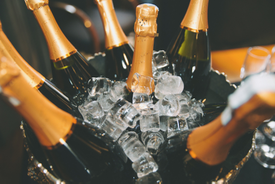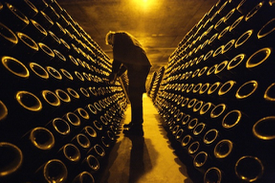
Sparkling wine on Ice
Bubbly is welcomed on any day and at any hour. If you are waiting for a special occasion to enjoy a glass of bubbly, you need to make some serious life changes today! Bubbly can make any day feel like a celebration, and I can’t imagine kicking off a dinner with friends without bubbly.
Of course, many will continue to associate bubbly with weddings, graduations, and New Year’s Eve.
While there are many great traditions observed around the globe, there are only two things required for New Year’s Eve: Sparkling Wine and Auld Lang Syne.
The World of Sparkling Wine (aka Bubbly)
Without question, we have to start with the most prominent bubbly of all – Champagne. Pretty much every wine from Champagne bubbles, while not all wines that bubble are Champagne. Got it?
Champagne is a well-defined region in the north of France known for producing the world’s most famous (some would suggest the best) sparkling wine. While most of the sparkling wines are pale in color, two-thirds of the permitted grapes in Champagne are red (Pinot Noir and Pinot Meunier), and the sole white grape is Chardonnay.
The unique sparkling wines of Champagne get their signature effervesces from a secondary fermentation in the bottle. These bubbles, which are natural to any fermentation, are captured in the bottle and forcibly absorbed by the wine since they have nowhere to go. This Traditional Method or Champagne Method (Methode Champenoise) is employed with all of the world’s best sparkling wines. (Get a detailed explanation of the Champagne Method, or Traditional Method HERE.)

Cellars in Champagne
Types or classes of Champagne/sparkling wine are important to note and greatly impact the price. The majority of the bubbly from Champagne is non-vintage, meaning that it is made with a blend of vintages to maintain consistency. You won’t often see the words “non-vintage” on the label, but you will note the absence of a vintage (year).
Next, there is vintage Champagne, which is, as the name suggests, a wine made entirely of the stated vintage. As expected, vintage Champagne is more expensive than non-vintage Champagne. The flavor differences between vintage and non-vintage Champagne are also factors of aging on lees. Non-vintage must spend a minimum of 15 months on the yeast introduced for the second fermentation bottle, while vintage Champagne requires a minimum of three years. The time the spent (dead or dormant) yeast is in the bottle (before they are expertly removed) contributes greatly to the sparkling wine’s aromatics, flavor, and texture.
At the top of the pyramid is the Prestige Cuvée, which is the top bubbly offered by a producer. A famous example is Moët & Chandon‘s Dom Pérignon. If you have to ask the price, you can’t afford it.
As described above, only sparkling wine made in the limited region of Champagne can rightly be called Champagne. Even sparkling wine made in France outside the Champagne region is not called Champagne. French sparkling wines not called Champagne are typically labeled as Crémant. Crémant from Loire and Alsace is particularly tasty and often sells for a fraction of the price of Champagne.
Italy has one of the world’s most recognized bubbly categories, Prosecco. Prosecco is made in the north of Italy, and it does not use the traditional method but rather what is known as the tank method.
The tank method uses the same principle as the traditional method, but instead of the secondary fermentation being done in the bottle, it’s performed in a large tank that captures the bubbles in the wine. As you can imagine, this is far less laborious than the traditional method and, therefore much less expensive to make.

Champagne Corks – Signs of a good night
Italy does make some very good traditional method sparkling wines, most notably in the district of Franciacorta and in the Trento DOC that recently adopted the clever Trentodoc moniker. Franciacorta can be nearly as expensive as Champagne and just as good. However, you rarely see Franciacorta in the USA, save the best wine shops and top Italian restaurants.
Spain gives us a great sparkling wine called Cava, a bubbly made in the traditional method without a high price tag. Cava must be aged a minimum of nine months on its lees. Elevated Cava designated as Cava de Guarda Superior includes Cava Reserva, Gran Reserva, and Cava de Paraje Calificado, ranging in age from 18 to 36 months minimum. Cava is perhaps the world’s greatest bubbly value.
In the New World, most notably the USA and Australia there are a wide range of sparkling wines ranging from serious traditional method bubbly to cheap and often dreadful tank method sparklers.
In California, several sparkling wines are produced by, or in conjunction with, famous Champagne producers. Often, the labels will bear the name of the French firm, so they are easy to spot. These are frequently among the best bubblies produced in the USA and are almost always cheaper than their French counterparts.
Sparkling Wine Terms Defined
Champagne/Sparkling Wine Styles:
- Blanc de Noir (white from black) indicating that the wine is made entirely with red grapes.
- Blanc de Blancs (white from white) made entirely with Chardonnay.
- Rosé is soft pink to ruby in color and most often dry.
Champagne/Sparkling Wine Dry to Sweet:
Champagne labels will also indicate sweetness. Most Champagne is dry, but there are varying degrees. These are the terms that you will encounter listed in order from driest to sweetest:
- Brut Zero (Brut Nature) — 0-3 grams/liter of sugar, this style has no added sugar.
- Extra Brut – 0-6 grams/liter/liter of sugar
- Brut – 0-12 grams/liter of sugar, this is the most common designation of dry Champagne
- Extra Dry – 12-17 grams/liter of sugar, when Brut is too dry try Extra Dry
- Sec (Dry) — 17-32 grams/liter of sugar
- Demi-Sec – 32-50 grams/liter of sugar
- Doux – 50+ grams/liter of sugar
The above list expresses grams per liter of sugar found in Sparkling Wine. Even Demi-Sec has about half of the sugar found in a typical Gin & Tonic.
A Simple Sparkling Wine Buying Guide
- First and foremost, get to know your local wine merchant. They will be able to direct you to the styles you desire, confine your search within your budget, and, over time, they will learn your taste preferences.
- On a serious budget? Look for quality Prosecco and Cava. Cava is often more complex and interesting, and you can find both for around $12 to $15 a bottle.
- Look for the California/French collaborations made in California. You can find these gems for $20 to $40 a bottle, and they will not disappoint.
- Seek out Franciacorta as this will offer great bubbly flavors and a great conversation starter, as most of your guests have never heard of it.
- Look for lesser-known Champagne brands that your wine merchant recommends. It’s hard to find Champagne for near or under $30, so let your wine seller search out the bargains for you.
- Consider a bottle or two of vintage Champagne to start the evening. Remember to always serve the best selection early in the night as opposed to late.
- And remember, bubbly does not require a special occasion. It is a welcome addition to any day of the year.

Champagne (bubbly) is a very food friendly wine and should be drunk more often. I serve Champagne with any Asian dish I cook or order out and the crowd is never disappointed.